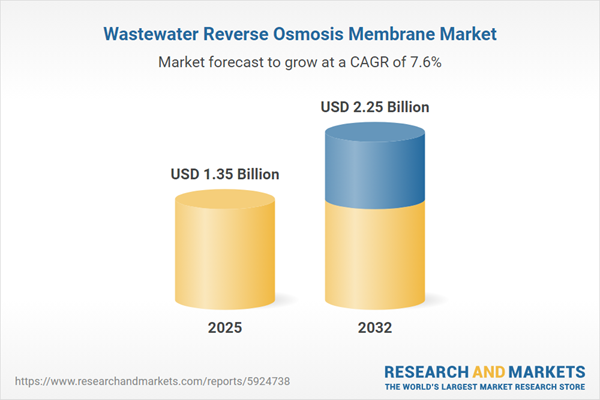Speak directly to the analyst to clarify any post sales queries you may have.
The Wastewater Reverse Osmosis Membrane Market is evolving rapidly in response to intensified water scarcity, regulatory demands, and industrial expansion. Senior decision-makers face unprecedented opportunities and complexities as this market reinvents wastewater treatment through advanced filtration, digital integration, and regional adaptation.
Market Snapshot: Wastewater Reverse Osmosis Membrane Market Growth
The Wastewater Reverse Osmosis Membrane Market grew from USD 1.25 billion in 2024 to USD 1.35 billion in 2025. It is expected to continue growing at a CAGR of 7.59%, reaching USD 2.25 billion by 2032.
Scope & Segmentation
This comprehensive analysis examines how the wastewater reverse osmosis membrane market’s evolution is shaped by technology, end-use, regional dynamics, and ongoing innovation.
- Membrane Types: Cellulose acetate, polyamide thin-film composite, thin-film nanocomposite
- Applications: Industrial, oil and gas, power generation
- Module Types: Hollow fiber, plate and frame, spiral wound
- End-Use Industries: Chemical processing (including petrochemical and specialty chemical), food and beverage (brewery and distillery, dairy and beverage, meat processing), pharmaceutical (biopharmaceutical, generic drugs), pulp and paper (kraft paper, recycled paper)
- Regional Coverage: Americas (United States, Canada, Mexico, Brazil, Argentina, Chile, Colombia, Peru); Europe, Middle East & Africa (United Kingdom, Germany, France, Russia, Italy, Spain, Netherlands, Sweden, Poland, Switzerland, United Arab Emirates, Saudi Arabia, Qatar, Turkey, Israel, South Africa, Nigeria, Egypt, Kenya); Asia-Pacific (China, India, Japan, Australia, South Korea, Indonesia, Thailand, Malaysia, Singapore, Taiwan)
- Companies Profiled: Toray Industries, Nitto Denko, DuPont de Nemours, SUEZ S.A., Pentair, LG Chem, Asahi Kasei, Toyobo, Koch Membrane Systems, Mitsubishi Chemical Corporation
Key Takeaways for Senior Decision-Makers
- Recent advances in polymer chemistry and membrane architecture have enabled superior contaminant removal and improved energy efficiency across diverse industry applications.
- Industries are leveraging modular and scalable membrane designs to retrofit or expand facilities cost-effectively, offering flexibility for both centralized and decentralized wastewater treatment needs.
- Integration of digital process monitoring and predictive maintenance significantly reduces operational disruptions and extends asset life, helping organizations manage maintenance schedules and preempt performance declines.
- Growing regional regulatory frameworks and sustainability targets are accelerating the adoption of advanced membranes, with markets in North America, Europe, Asia-Pacific, and Latin America adapting technologies for local feedwater needs and infrastructure limitations.
- Chemical, food and beverage, pharmaceuticals, oil and gas, and pulp and paper sectors are each seeking industry-specific solutions, driving demand for customized membrane configurations and compliance with unique operational and hygiene standards.
Tariff Impact and Strategic Responses
The introduction of new US tariffs on imported reverse osmosis membranes in 2025 is reshaping the global supply structure. Companies are mitigating these shifts with increased onshore manufacturing, adaptive sourcing agreements, and closer evaluation of supplier sustainability practices. These changes are prompting a strategic realignment in procurement and investment planning throughout the value chain.
Research Methodology & Data Sources
Data and insights are anchored in rigorous secondary research, including scientific publications, technical standards, and regulatory filings, complemented by primary interviews with industry participants and experts. Cross-validation and scenario analysis underpin reliability, while expert reviews ensure robust and actionable outputs.
Why This Report Matters
- Enables strategic planning aligned with global sustainability, regulatory, and supply chain trends among wastewater treatment and industrial leaders.
- Delivers practical guidance for selecting optimal membrane types, modules, and operating models based on site-specific operational and compliance goals.
- Empowers procurement and engineering teams with insight into technology advances and market shifts for informed investment decisions.
Conclusion
The wastewater reverse osmosis membrane market is poised for continued growth as technology, regulation, and industry demands converge. Forward-looking strategies anchored in innovation and regional nuance will drive future competitiveness and value creation in this evolving sector.
Additional Product Information:
- Purchase of this report includes 1 year online access with quarterly updates.
- This report can be updated on request. Please contact our Customer Experience team using the Ask a Question widget on our website.
Table of Contents
3. Executive Summary
4. Market Overview
7. Cumulative Impact of Artificial Intelligence 2025
Companies Mentioned
The companies profiled in this Wastewater Reverse Osmosis Membrane market report include:- Toray Industries, Inc.
- Nitto Denko Corporation
- DuPont de Nemours, Inc.
- SUEZ S.A.
- Pentair plc
- LG Chem, Ltd.
- Asahi Kasei Corporation
- Toyobo Co., Ltd.
- Koch Membrane Systems, Inc.
- Mitsubishi Chemical Corporation
Table Information
| Report Attribute | Details |
|---|---|
| No. of Pages | 183 |
| Published | October 2025 |
| Forecast Period | 2025 - 2032 |
| Estimated Market Value ( USD | $ 1.35 Billion |
| Forecasted Market Value ( USD | $ 2.25 Billion |
| Compound Annual Growth Rate | 7.5% |
| Regions Covered | Global |
| No. of Companies Mentioned | 11 |









